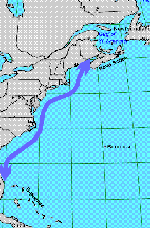
Search Journey North
return to:

 A/CPB
A/CPB
Right Whale Migration Update: April 1, 1998
Today's Report Includes:
- First Mother-calf Pair Spotted in Cape Cod Bay
- Right Whales Leave Southeastern Critical Habitat
- Field Report: Tagging A Right Whale
- Challenge Question # 5
- How To Respond To Today's Challenge Question
To: Journey North
From: Anne Smrcina
Greetings from the Stellwagen Bank National
Marine Sanctuary:
First Mother-calf Pair Spotted in Cape Cod
Bay
HOORAY! We've had a reported sighting of a mother-calf pair in Cape Cod Bay. The
pair was spotted on St. Patrick's Day (March 17th), just a little too late to make
it into my last report. I haven't heard of any other mother-calf sightings to date,
although numerous other whales have been seen in Cape Cod Bay, and an occasional
whale in the Great South Channel.
Right Whales Leave Southeastern Critical Habitat
 |
|
Migration Route of North Atlantic Right Whales Map courtesy of |
Field Report: Tagging A Right Whale
I did get to go out with a researcher and tag a right whale last week. David Wiley of the International Wildlife Coalition, with funding from the Massachusetts Environmental Trust, is attempting to place radio tags on right whales. These tags are actually small waterproof packages of equipment which record the animals meanderings through Cape Cod Bay, its dive times and depths, and other environmental data.
You may have heard about satellite tags in addition to radio tags, but do you know the difference? See if you can answer this:
Challenge Question # 5
"What are the major differences between these two types of tags and what types of data would be best collected with which tag?"
(To respond to this Challenge Question, please follow the instructions at the
end of this report)
Within an hour of leaving port we came upon a pair of whales feeding on subsurface
copepods (a small, shrimp-like crustacean). Balancing like an aerial tightrope walker,
Wiley moved out onto the pulpit -- an extra-long (but extremely narrow) extension
of the boat on the bow. He carried a 10-foot pole, at the end of which was the radio
tag.
Unlike other researchers, who often use hooks that grab into the skin and blubber
to attach the tag, Wiley uses a suction cup (this is a non-invasive technique that
appears to have no effect at all on the whale's behavior). A thick coating of gel
is applied to the cup to make it stick better (those of you who have had an EKG
(electrocardiogram) or have watched medical shows on TV may be familiar with this
process). Then, our boat's captain brought us right up alongside one of the whales
(we were actually moving between two whales, each of which was larger than the 30-foot
vessel). Wiley, looking a bit like Captain Ahab stayed poised on the pulpit, waiting
for the appropriate time to "strike."
Just before the whale dove down into the depths, his arm moved quickly -- pushing
the pole towards the whale until the suction cup was securely placed on the whale's
back. The backward motion detached the velcro strap that secured the tag to the
pole -- and we had a tagged whale. Now all we had to do was follow the whale until
the suction cup gave up its hold and the tag floated free (Wiley warned me that this
might take as much as 12-15 hours).
Luckily, we had magnificent weather, sunny and mild with very little wind. For a
couple of hours we followed the whale at a fairly close distance, attempting to take
identifying photos of its callosity patterns. We lost sight of the whale for a few
hours in the early afternoon, although we did spot several other whales. Fortune
smiled on us that day, for as the afternoon was waning we got a steady signal from
the radio tag -- meaning that it was floating at the surface (you cannot get a signal
when the whale and tag are underwater). We were able to home in on the radio signal
and find the tag (and all its stored data), getting back to the dock just after 4pm
in the
afternoon.
Not all right whale tagging expeditions go as smoothly. Very often finding the whales
can be a long and time-consuming task. We were lucky that it only took us an hour.
Radio tags and other equipment can and often do fail (the ocean environment is notoriously
hard on electronics), and whales may not cooperate with the agenda (it took us an
hour of following the whales to apply the tag -- it could have taken lots longer).
Very often field research involves hours and hours of searching in less than ideal
conditions, followed by moments of total excitement. What is required is a love
of animals, a love of the process of research and the search for knowledge, and a
large amount of patience. This sort of work can't be hurried -- and the animal's
welfare must be the first priority.
I hope to have some data from Wiley's research project for you in my next report.
Until then, this is Anne Smrcina, education coordinator of the Stellwagen
Bank National Marine Sanctuary signing off.
How to Respond to Today's Challenge Question
1. Address an e-mail message to: jn-challenge-rwhale@learner.org
2. In the Subject Line of your message write: Challenge Question # 5
3. In the body of the message, give your answer to this question:
Challenge Question # 5
"What are the major differences between these two types of tags and what types of data would be best collected with which tag?"
The Next Right Whale Update Will Be Posted on April 15, 1998
Copyright 1998 Journey North. All Rights Reserved.





